A European Database of Fusarium graminearum and F. culmorum Trichothecene Genotypes
- PMID: 27092107
- PMCID: PMC4821861
- DOI: 10.3389/fmicb.2016.00406
A European Database of Fusarium graminearum and F. culmorum Trichothecene Genotypes
Abstract
Fusarium species, particularly Fusarium graminearum and F. culmorum, are the main cause of trichothecene type B contamination in cereals. Data on the distribution of Fusarium trichothecene genotypes in cereals in Europe are scattered in time and space. Furthermore, a common core set of related variables (sampling method, host cultivar, previous crop, etc.) that would allow more effective analysis of factors influencing the spatial and temporal population distribution, is lacking. Consequently, based on the available data, it is difficult to identify factors influencing chemotype distribution and spread at the European level. Here we describe the results of a collaborative integrated work which aims (1) to characterize the trichothecene genotypes of strains from three Fusarium species, collected over the period 2000-2013 and (2) to enhance the standardization of epidemiological data collection. Information on host plant, country of origin, sampling location, year of sampling and previous crop of 1147 F. graminearum, 479 F. culmorum, and 3 F. cortaderiae strains obtained from 17 European countries was compiled and a map of trichothecene type B genotype distribution was plotted for each species. All information on the strains was collected in a freely accessible and updatable database (www.catalogueeu.luxmcc.lu), which will serve as a starting point for epidemiological analysis of potential spatial and temporal trichothecene genotype shifts in Europe. The analysis of the currently available European dataset showed that in F. graminearum, the predominant genotype was 15-acetyldeoxynivalenol (15-ADON) (82.9%), followed by 3-acetyldeoxynivalenol (3-ADON) (13.6%), and nivalenol (NIV) (3.5%). In F. culmorum, the prevalent genotype was 3-ADON (59.9%), while the NIV genotype accounted for the remaining 40.1%. Both, geographical and temporal patterns of trichothecene genotypes distribution were identified.
Keywords: Fusarium; acetyldeoxynivalenol; chemotype; database; genotype; mycotoxin; nivalenol; trichothecene.
Figures






References
-
- Aamot H. U., Ward T. J., Brodal G., Vrålstad T., Larsen G. B., Klemsdal S. S., et al. (2015). Genetic and phenotypic diversity within the Fusarium graminearum species complex in Norway. Eur. J. Plant Pathol. 142, 501–519. 10.1007/s10658-015-0629-4 - DOI
-
- Abbà S., Birello G., Vallino M., Perin A., Ghignone S., Caciagli P. (2015). Shall we share? A repository for open research data in agriculture and environmental sciences. EPPO Bull. 45, 311–316. 10.1111/epp.12212 - DOI
-
- Abd-Elsalam K. A., Yassin M. A., Moslem M. A., Bahkali A. H., de Wit P. J. G. M., McKenzie E. H. C., et al. (2010). Culture collections, the new herbaria for fungal pathogens. Fungal Divers. 45, 21–32. 10.1007/s13225-010-0063-z - DOI
-
- Aoki T., Ward T. J., Kistler H. C., O'Donnell K. (2012). Systematics, phylogeny and trichothecene mycotoxin potential of Fusarium head blight cereal pathogens. JSM Mycotoxins 62, 91–102. 10.2520/myco.62.91 - DOI
LinkOut - more resources
Full Text Sources
Other Literature Sources
Miscellaneous

